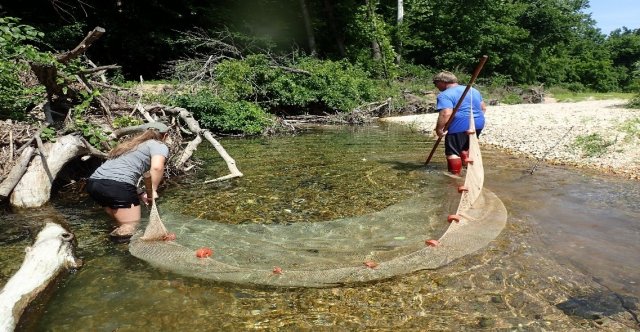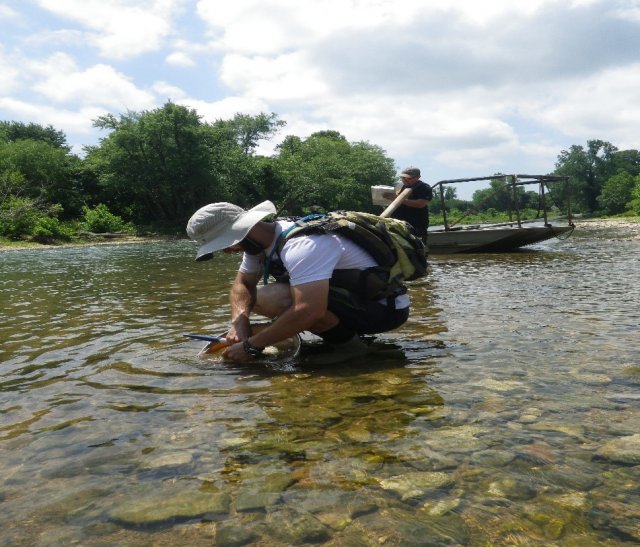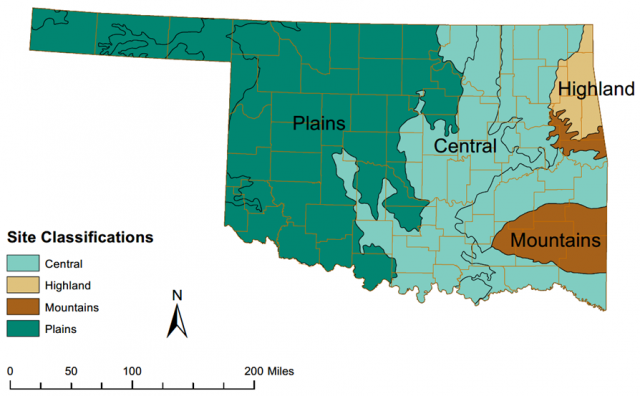EPA Researchers Work with Oklahoma Partners to Evaluate Ecological Conditions of Wadeable Streams and Restore Valuable Water Resources

Published October 18, 2021
Aquatic ecosystems, such as lakes, streams and rivers, play an important role in both human and environmental health. To protect these resources, it’s first important to assess their health. Aquatic ecosystems are complex and measuring the health of a stream isn’t as simple as, say, taking its temperature. To measure stream health, scientists often look at its biological condition, which is a term for the abundance and variety of aquatic organisms that call that stream home. This approach is based on the idea that the health of a stream’s aquatic organisms will reflect the cumulative conditions of all the stream’s components and processes.
Scientists evaluate biological condition based on metrics, also known as indices, that measure the ecological complexity of a waterbody. These indices may include species richness, tolerance, habitat, a species’ position in the ecosystem chain, and taxonomic complexity (the makeup of a species’ characteristics and relationships with organisms in similar classifications). A waterbody’s index score represents its biological condition and is used as the ultimate indicator of watershed health. Healthy streams typically have more diverse and more stable populations of aquatic organisms, while less healthy streams typically have less stable and less diverse populations.

To understand the qualities that must be present to support a healthy waterbody, scientists must evaluate the biological criteria of the water. EPA works closely with states to ensure that biological criteria and assessment methods for bodies of water are regionally relevant, while remaining consistent with the Clean Water Act. Since 2002, Oklahoma has advanced their water quality monitoring programs to support and reflect amendments to the state’s biological criteria. In 2013, an external evaluation of Oklahoma’s biological and water quality programs, conducted by the Midwest Biodiversity Institute, provided recommendations on how to account for natural variability, reference site selection, reference conditions, ecological attributes, and discriminatory capacity (MBI 2014).
To help address these recommendations, EPA researchers worked with the Oklahoma Water Resources Board (OWRB) and the Oklahoma Conservation Commission (OCC) to refine their current biological indices. The goal of this effort was to improve bioassessments based on fish and macroinvertebrate assemblages in wadeable streams throughout the state. Wadeable streams are ecologically important because they feed into larger waterways and serve as habitats for many aquatic organisms. They are referred to as “wadeable” because sampling can be conducted safely by wading into them.
To begin the effort, OWRB and OCC contributed macroinvertebrate, fish, habitat, and water chemistry data which were compiled in a relational database, along with landscape condition and water quality data. EPA researchers then used this data to address the recommendations, which included:
- developing a quantitative stressor gradient approach that will help researchers predict positive and negative reactions within waterbodies;
- accounting for regional variation in streams; and
- updating and improving the fish and macroinvertebrate Indices of Biological Integrity (IBIs).

Researchers used a combination of statistical analyses and expert judgement to identify sites with relatively little disturbance, sites with severe stress, and several categories in between. A site classification scheme was then developed to better account for regional variability of natural conditions. The Oklahoma ecoregions were distinguished into four site classes: Plains, Central Oklahoma, Highlands, and Mountains (Figure 1).
The project team calculated fish and macroinvertebrate metrics based on traits related to stress tolerance, feeding strategies, habitat use, and reproductive strategy. Metrics that had strong and consistent responses in signaling stress across site classes were preferred to measurements that responded inconsistently in different site classes. Metrics that passed the evaluation tests were combined to construct Indices of Biological Integrity (IBIs) for fish and macroinvertebrates within site classes, allowing researchers to evaluate and monitor any environmental stressors or patterns amongst the sites.
“Oklahoma has invested significantly in bioassessment as an absolute priority in evaluating stream health,” said Greg Kloxin, OCC Water Quality Division Assistant Director states. “We were extremely privileged to work with EPA ORD and other nationally recognized leaders in this field to accomplish this critical examination and revision of our assessment frame, metrics, and IBIs.”
The updated indices showed good performance in terms of the agreement between index scores and disturbance categories. The index development process was a successful step in helping OWRB and OCC provide improved indices for macroinvertebrates applicable to Oklahoma wadeable streams which can be used to assess the degree of disturbance, restoration progress, and/or attainment of the aquatic life use categories identified by the state.
“This continuing work will allow Oklahoma to reliably and with great confidence recalibrate biological expectations for our streams and rivers,” said Monty Porter, Assistant Chief of Water Quality for OWRB states.
“The tools developed from this study will help scientists and regulators better understand the conditions of Oklahoma’s wadeable streams, which in turn helps them restore and protect these valuable water resources,” said Acting Regional Administrator David Gray. “This important advancement would not have been possible without the partnership and cooperation of the Oklahoma Water Resources Board and the Oklahoma Conservation Commission.”
